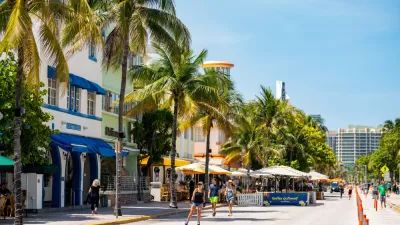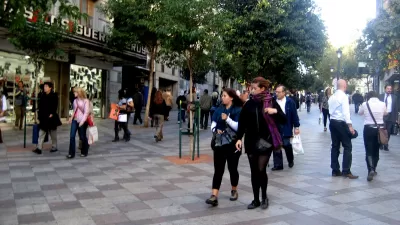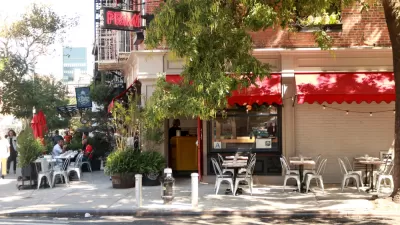With more people getting back in their cars, can pedestrian-oriented open streets survive?

When the pandemic forced restaurants to find creative ways to serve customers and people found themselves having to stay safe and sane in their own small neighborhoods, the concept of "open streets" caught on around the country as communities sought new ways to reclaim street space from cars and provide more safe outdoor space for residents. However, with COVID-19 restrictions starting to lift, writes Danielle Mudio for Politico, many formerly "open" streets have reverted to their original use.
At the height of pandemic planning, after initial reluctance from Mayor De Blasio, New York City pledged to pedestrianize 100 miles of roadway. Community groups took matters into their own hands, too: in Jackson Heights, volunteers raised $20,000 to create a 26-block open streets zone on 34th Avenue. But of the 83 miles of roadway that were eventually opened for pedestrian use during the pandemic, 22 have since shut down; "half were closed permanently while the rest shuttered temporarily for the winter, said Mitch Schwartz, a spokesperson for the de Blasio administration."
While most open streets programs were managed by volunteers, advocates say that "a redesign of city streets to include more permanent barriers, new signs and extra seating is necessary to keep cars off the roads and ensure they can be safely used by all." Because the programs often require "heroic or unusual effort by the community," writes Mudio, not all neighborhoods have the resources to maintain open streets programs without assistance from the city. Now, a coalition of "roughly 60 transportation and neighborhood groups" is calling for the city to "dedicate resources to support volunteers, provide amenities like improved barriers and provide daily programming activities." For their part, the city claims they are "considering a model that would provide reimbursement funding and technical assistance to community partners who lack resources" to implement and maintain open streets.
FULL STORY: Open Streets closed: Cars are reclaiming city blocks set aside for recreation

Alabama: Trump Terminates Settlements for Black Communities Harmed By Raw Sewage
Trump deemed the landmark civil rights agreement “illegal DEI and environmental justice policy.”

Planetizen Federal Action Tracker
A weekly monitor of how Trump’s orders and actions are impacting planners and planning in America.

The 120 Year Old Tiny Home Villages That Sheltered San Francisco’s Earthquake Refugees
More than a century ago, San Francisco mobilized to house thousands of residents displaced by the 1906 earthquake. Could their strategy offer a model for the present?

In Both Crashes and Crime, Public Transportation is Far Safer than Driving
Contrary to popular assumptions, public transportation has far lower crash and crime rates than automobile travel. For safer communities, improve and encourage transit travel.

Report: Zoning Reforms Should Complement Nashville’s Ambitious Transit Plan
Without reform, restrictive zoning codes will limit the impact of the city’s planned transit expansion and could exclude some of the residents who depend on transit the most.

Judge Orders Release of Frozen IRA, IIJA Funding
The decision is a victory for environmental groups who charged that freezing funds for critical infrastructure and disaster response programs caused “real and irreparable harm” to communities.
Urban Design for Planners 1: Software Tools
This six-course series explores essential urban design concepts using open source software and equips planners with the tools they need to participate fully in the urban design process.
Planning for Universal Design
Learn the tools for implementing Universal Design in planning regulations.
Clanton & Associates, Inc.
Jessamine County Fiscal Court
Institute for Housing and Urban Development Studies (IHS)
City of Grandview
Harvard GSD Executive Education
Toledo-Lucas County Plan Commissions
Salt Lake City
NYU Wagner Graduate School of Public Service





























